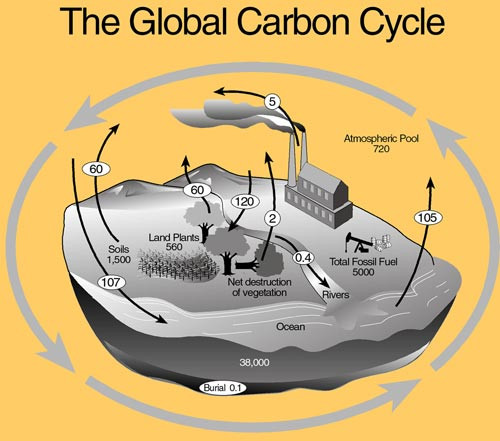Where is carbon stored on Earth?
We often talk about carbon, about how it pollutes the environment . but do you know how carbon is made and where it is stored on Earth?
It seems that every day there is news of rising carbon concentrations, carbon emissions and even people seeking new carbon-based life forms. But if you ask someone where the carbon will be stored on Earth, they may not have a satisfactory answer for you.

Carbon is the sixth most abundant element in the universe and 15th in the Earth's crust.
Carbon is a chemical element. It is the sixth most common element in the universe and the 15th in the Earth's crust. Unlike many other chemical elements, you can find many different forms of carbon existence. Diamonds, pencil bowels . all come from carbon. But the Earth does not store most of the carbon in the form of diamonds and coal used as pencil bowls - only a very small portion of carbon is used in the jewelry (diamond) and education industry (pencils).
Amorphous carbon is the third form of carbon and is difficult to see because it does not exist in the form of crystals like diamonds.
So where is this carbon "hiding" on Earth? Carbon is a material that contributes to life on Earth (that's why scientists are trying to find life on other carbon-based planets).Carbon is present in living and dead bodies. This means that not only in the body can we find carbon in fossil fuels.
Carbon is also found in the atmosphere - where it is part of carbon dioxide emitted when burning fossil fuels or by breathing organisms. Carbon also exists in organic matter from soil and rock.
In addition, a large amount of carbon on Earth is stored in a surprising place: the oceans . It is estimated that there are between 38,000 and 40,000 billion tons of carbon in the ocean itself and 66 million -100 million tons of carbon in sediments and sedimentary rocks on the ocean floor. Sediments and rocks develop from hard shells and body parts of marine organisms that absorb carbon in the water. When they die, their bodies sink to the ocean floor and the hardware breaks into sediment and later contributes to sedimentary rock formation.
- Discovery of carbon and life in the heart of the Earth
- Carbon is not the enemy of the Earth, the world needs to reconsider it
- Measuring carbon to save tropical forests
- Black carbon heated the earth twice as strongly as predicted
- Discovered a giant melted carbon reservoir in the United States
- Fossil-filled fossil soil was found
- A collision can start life on Earth
- Low-carbon biological materials: Many environmentally friendly
- Geoengineering - the last hope for Earth's climate?
- The time bomb of the climate
- Gulf Stream warm currents are releasing methane from the sea floor
- Prevent soot to help reduce Earth temperature
 Is the magnetic North Pole shift dangerous to humanity?
Is the magnetic North Pole shift dangerous to humanity? Washington legalizes the recycling of human bodies into fertilizer
Washington legalizes the recycling of human bodies into fertilizer Lightning stone - the mysterious guest
Lightning stone - the mysterious guest Stunned by the mysterious sunset, strange appearance
Stunned by the mysterious sunset, strange appearance